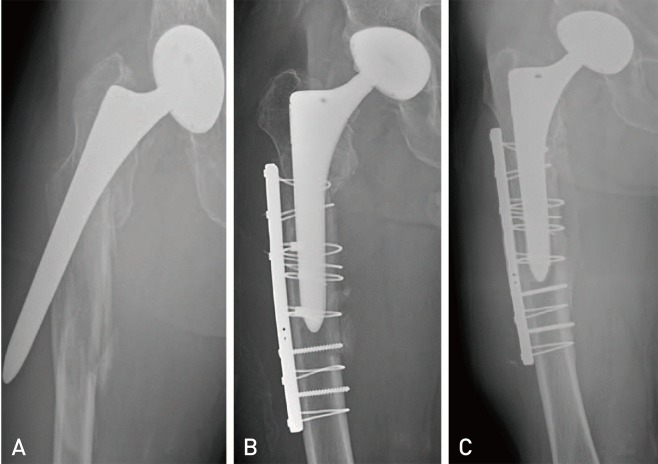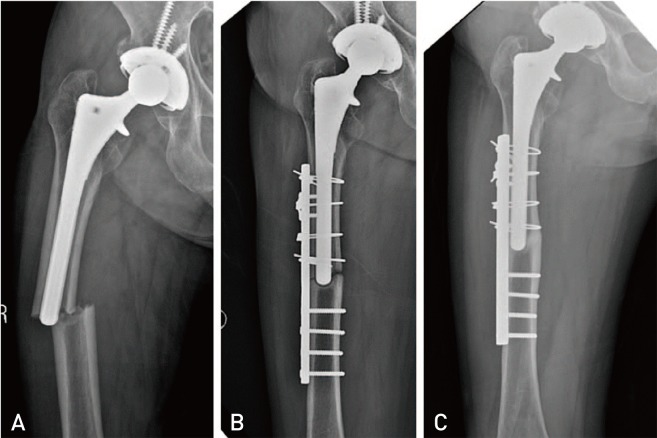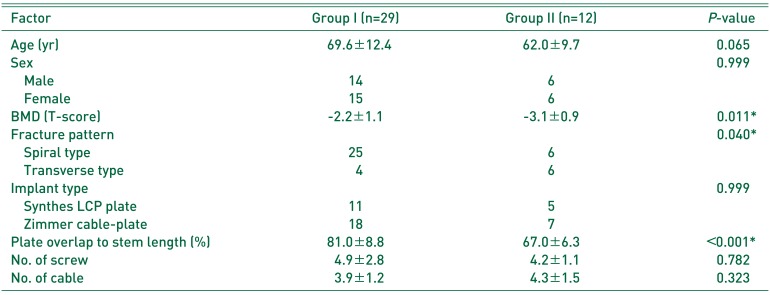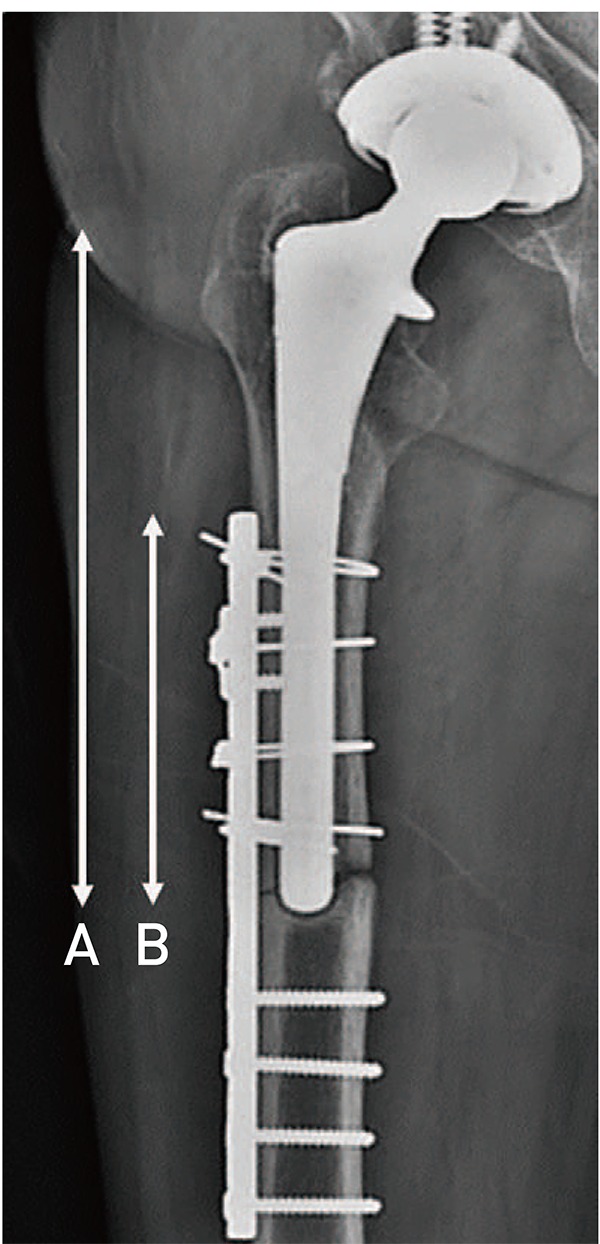1. Brand S, Ettinger M, Omar M, Hawi N, Krettek C, Petri M. Concepts and potential future developments for treatment of periprosthetic proximal femoral fractures. Open Orthop J. 2015; 9:405–411. PMID:
26401164.

2. Campbell P, McWilliams TG. Periprosthetic femoral fractures. Curr Orthop. 2002; 16:126–132.

3. Kim MW, Chung YY, Lee JH, Park JH. Outcomes of surgical treatment of periprosthetic femoral fractures in cementless hip arthroplasty. Hip Pelvis. 2015; 27:146–151. PMID:
27536618.

4. Zheng L, Lee WY, Hwang DS, Kang C, Noh CK. Could patient undergwent surgical treatment for periprosthetic femoral fracture after hip arthroplasty return to their status before trauma? Hip Pelvis. 2016; 28:90–97. PMID:
27536650.

5. Lindahl H, Malchau H, Herberts P, Garellick G. Periprosthetic femoral fractures classification and demographics of 1049 periprosthetic femoral fractures from the Swedish National Hip Arthroplasty Register. J Arthroplasty. 2005; 20:857–865. PMID:
16230235.
6. Lindahl H. Epidemiology of periprosthetic femur fracture around a total hip arthroplasty. Injury. 2007; 38:651–654. PMID:
17477925.

7. Lindahl H, Garellick G, Regnér H, Herberts P, Malchau H. Three hundred and twenty-one periprosthetic femoral fractures. J Bone Joint Surg Am. 2006; 88:1215–1222. PMID:
16757753.

8. Brady OH, Garbuz DS, Masri BA, Duncan CP. The reliability and validity of the Vancouver classification of femoral fractures after hip replacement. J Arthroplasty. 2000; 15:59–62. PMID:
10654463.
9. Xue H, Tu Y, Cai M, Yang A. Locking compression plate and cerclage band for type B1 periprosthetic femoral fractures preliminary results at average 30-month follow-up. J Arthroplasty. 2011; 26:467–471. PMID:
20570098.
10. Tadross TS, Nanu AM, Buchanan MJ, Checketts RG. Dall-Miles plating for periprosthetic B1 fractures of the femur. J Arthroplasty. 2000; 15:47–51. PMID:
10654461.

11. Park SK, Kim YG, Kim SY. Treatment of periprosthetic femoral fractures in hip arthroplasty. Clin Orthop Surg. 2011; 3:101–106. PMID:
21629469.

12. Chun YS, Lee JS, Cho YJ, Rhyu KH. Periprosthetic insufficiency fracture around radiographically loose cemented stem: a report of two cases. Hip Pelvis. 2015; 27:183–186. PMID:
27536623.

13. Ricci WM, Bolhofner BR, Loftus T, Cox C, Mitchell S, Borrelli J Jr. Indirect reduction and plate fixation, without grafting, for periprosthetic femoral shaft fractures about a stable intramedullary implant. Surgical technique. J Bone Joint Surg Am. 2006; 88 Suppl 1 Pt 2:275–282. PMID:
16951099.
14. Lewis GS, Caroom CT, Wee H, et al. Tangential bicortical locked fixation improves stability in Vancouver B1 periprosthetic femur fractures: a biomechanical study. J Orthop Trauma. 2015; 29:e364–e370. PMID:
26053467.
15. Kelley SS. Periprosthetic femoral fractures. J Am Acad Orthop Surg. 1994; 2:164–172. PMID:
10709005.

16. Serocki JH, Chandler RW, Dorr LD. Treatment of fractures about hip prostheses with compression plating. J Arthroplasty. 1992; 7:129–135. PMID:
1613518.

17. Lever JP, Zdero R, Nousiainen MT, Waddell JP, Schemitsch EH. The biomechanical analysis of three plating fixation systems for periprosthetic femoral fracture near the tip of a total hip arthroplasty. J Orthop Surg Res. 2010; 5:45. PMID:
20653962.

18. Wilson D, Frei H, Masri BA, Oxland TR, Duncan CP. A biomechanical study comparing cortical onlay allograft struts and plates in the treatment of periprosthetic femoral fractures. Clin Biomech (Bristol, Avon). 2005; 20:70–76.

19. Dennis MG, Simon JA, Kummer FJ, Koval KJ, Di Cesare PE. Fixation of periprosthetic femoral shaft fractures: a biomechanical comparison of two techniques. J Orthop Trauma. 2001; 15:177–180. PMID:
11265007.

20. Dennis MG, Simon JA, Kummer FJ, Koval KJ, DiCesare PE. Fixation of periprosthetic femoral shaft fractures occurring at the tip of the stem: a biomechanical study of 5 techniques. J Arthroplasty. 2000; 15:523–528. PMID:
10884215.
21. Learmonth ID. The management of periprosthetic fractures around the femoral stem. J Bone Joint Surg Br. 2004; 86:13–19. PMID:
14765858.

22. Ehlinger M, Adam P, Moser T, Delpin D, Bonnomet F. Type C periprosthetic fractures treated with locking plate fixation with a mean follow up of 2.5 years. Orthop Traumatol Surg Res. 2010; 96:44–48. PMID:
20170856.

23. Schütz M, Müller M, Krettek C, et al. Minimally invasive fracture stabilization of distal femoral fractures with the LISS: a prospective multicenter study. Results of a clinical study with special emphasis on difficult cases. Injury. 2001; 32 Suppl 3:SC48–SC54. PMID:
11888194.

24. Kolb W, Guhlmann H, Friedel R, Nestmann H. [Fixation of periprosthetic femur fractures with the less invasive stabilization system (LISS): a new minimally invasive treatment with locked fixed-angle screws]. Zentralbl Chir. 2003; 128:53–59. German. PMID:
12594614.
25. Min BW, Cho CH, Son ES, Lee KJ, Lee SW, Min KK. Minimally invasive plate osteosynthesis with locking compression plate in patients with Vancouver type B1 periprosthetic femoral fractures. Injury. 2018; 49:1336–1340. PMID:
29807829.

26. Corten K, Vanrykel F, Bellemans J, Frederix PR, Simon JP, Broos PL. An algorithm for the surgical treatment of periprosthetic fractures of the femur around a well-fixed femoral component. J Bone Joint Surg Br. 2009; 91:1424–1430. PMID:
19880884.

27. Howell JR, Masri BA, Garbuz DS, Greidanus NV, Duncan CP. Cable plates and onlay allografts in periprosthetic femoral fractures after hip replacement: laboratory and clinical observations. Instr Course Lect. 2004; 53:99–110. PMID:
15116604.
28. Kim YH, Mansukhani SA, Kim JS, Park JW. Use of locking plate and strut onlay allografts for periprosthetic fracture around well-fixed femoral components. J Arthroplasty. 2017; 32:166–170. PMID:
27407037.

29. Moore RE, Baldwin K, Austin MS, Mehta S. A systematic review of open reduction and internal fixation of periprosthetic femur fractures with or without allograft strut, cerclage, and locked plates. J Arthroplasty. 2014; 29:872–876. PMID:
24650900.









 PDF
PDF ePub
ePub Citation
Citation Print
Print




 XML Download
XML Download